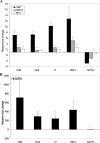Genome-wide expression and location analyses of the Candida albicans Tac1p regulon
- PMID: 17905926
- PMCID: PMC2168409
- DOI: 10.1128/EC.00327-07
Genome-wide expression and location analyses of the Candida albicans Tac1p regulon
Abstract
A major mechanism of azole resistance in Candida albicans is overexpression of the genes encoding the ATP binding cassette transporters Cdr1p and Cdr2p due to gain-of-function mutations in Tac1p, a transcription factor of the zinc cluster family. To identify the Tac1p regulon, we analyzed four matched sets of clinical isolates representing the development of CDR1- and CDR2-mediated azole resistance by using gene expression profiling. We identified 31 genes that were consistently up-regulated with CDR1 and CDR2, including TAC1 itself, and 12 consistently down-regulated genes. When a resistant strain deleted for TAC1 was examined similarly, expression of almost all of these genes returned to levels similar to those in the matched azole-susceptible isolate. Using genome-wide location (ChIP-chip) analysis (a procedure combining chromatin immunoprecipitation with hybridization to DNA intergenic microarrays), we found 37 genes whose promoters were bound by Tac1p in vivo, including CDR1 and CDR2. Sequence analysis identified nine new genes whose promoters contain the previously reported Tac1p drug-responsive element (CGGN(4)CGG), including TAC1. In total, there were eight genes whose expression was modulated in the four azole-resistant clinical isolates in a TAC1-dependent manner and whose promoters were bound by Tac1p, qualifying them as direct Tac1p targets: CDR1, CDR2, GPX1 (putative glutathione peroxidase), LCB4 (putative sphingosine kinase), RTA3 (putative phospholipid flippase), and orf19.1887 (putative lipase), as well as IFU5 and orf19.4898 of unknown function. Our results show that Tac1p binds under nonactivating conditions to the promoters of its targets, including to its own promoter. They also suggest roles for Tac1p in regulating lipid metabolism (mobilization and trafficking) and oxidative stress response in C. albicans.
Figures



Similar articles
-
Functional analysis of cis- and trans-acting elements of the Candida albicans CDR2 promoter with a novel promoter reporter system.Eukaryot Cell. 2009 Aug;8(8):1250-67. doi: 10.1128/EC.00069-09. Epub 2009 Jun 26. Eukaryot Cell. 2009. PMID: 19561319 Free PMC article.
-
TAC1, transcriptional activator of CDR genes, is a new transcription factor involved in the regulation of Candida albicans ABC transporters CDR1 and CDR2.Eukaryot Cell. 2004 Dec;3(6):1639-52. doi: 10.1128/EC.3.6.1639-1652.2004. Eukaryot Cell. 2004. PMID: 15590837 Free PMC article.
-
The zinc cluster transcription factor Tac1p regulates PDR16 expression in Candida albicans.Mol Microbiol. 2007 Oct;66(2):440-52. doi: 10.1111/j.1365-2958.2007.05931.x. Mol Microbiol. 2007. PMID: 17897373
-
The H741D mutation in Tac1p contributes to the upregulation of CDR1 and CDR2 expression in Candida albicans.Braz J Microbiol. 2020 Dec;51(4):1553-1561. doi: 10.1007/s42770-020-00336-8. Epub 2020 Jul 9. Braz J Microbiol. 2020. PMID: 32648240 Free PMC article.
-
The TAC1 Gene in Candida albicans: Structure, Function, and Role in Azole Resistance: A Mini-Review.Microb Drug Resist. 2024 Jul;30(7):288-296. doi: 10.1089/mdr.2023.0334. Epub 2024 May 21. Microb Drug Resist. 2024. PMID: 38770776 Review.
Cited by
-
RNA sequencing revealed novel actors of the acquisition of drug resistance in Candida albicans.BMC Genomics. 2012 Aug 16;13:396. doi: 10.1186/1471-2164-13-396. BMC Genomics. 2012. PMID: 22897889 Free PMC article.
-
The synthesis, regulation, and functions of sterols in Candida albicans: Well-known but still lots to learn.Virulence. 2016 Aug 17;7(6):649-59. doi: 10.1080/21505594.2016.1188236. Epub 2016 May 24. Virulence. 2016. PMID: 27221657 Free PMC article. Review.
-
Functional analysis of cis- and trans-acting elements of the Candida albicans CDR2 promoter with a novel promoter reporter system.Eukaryot Cell. 2009 Aug;8(8):1250-67. doi: 10.1128/EC.00069-09. Epub 2009 Jun 26. Eukaryot Cell. 2009. PMID: 19561319 Free PMC article.
-
Contribution of CgPDR1-regulated genes in enhanced virulence of azole-resistant Candida glabrata.PLoS One. 2011 Mar 9;6(3):e17589. doi: 10.1371/journal.pone.0017589. PLoS One. 2011. PMID: 21408004 Free PMC article.
-
Molecular dissection studies of TAC1, a transcription activator of Candida drug resistance genes of the human pathogenic fungus Candida albicans.Front Microbiol. 2023 Jul 12;14:994873. doi: 10.3389/fmicb.2023.994873. eCollection 2023. Front Microbiol. 2023. PMID: 37502396 Free PMC article.
References
-
- Angus-Hill, M. L., A. Schlichter, D. Roberts, H. Erdjument-Bromage, P. Tempst, and B. R. Cairns. 2001. A Rsc3/Rsc30 zinc cluster dimer reveals novel roles for the chromatin remodeler RSC in gene expression and cell cycle control. Mol. Cell 7:741-751. - PubMed
-
- Avery, A. M., and S. V. Avery. 2001. Saccharomyces cerevisiae expresses three phospholipid hydroperoxide glutathione peroxidases. J. Biol. Chem. 276:33730-33735. - PubMed
Publication types
MeSH terms
Substances
Grants and funding
LinkOut - more resources
Full Text Sources
Molecular Biology Databases
Miscellaneous

